FRIENDS OF CLAINES CHuRCH
The Secrets of Claines Tower
(The Tower, its bells and bell ringers)
By Geoff Sansome

Having done as much detective work as is possible outside the bell chamber then we can begin our journey to see the bells and their surroundings as they are today.
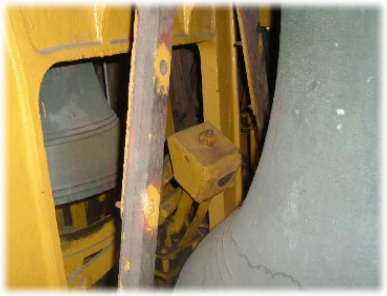
The chiming hammer on the tenor bell, linked by wire to the clock motor.
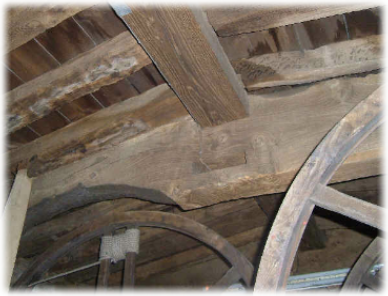
Looking up, the ceiling of the tower, and the tie off point for the bell rope on the bell wheel

At the top of the bell chamber looking down on bells 3, 10 and 9


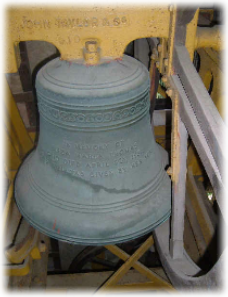
BELLS 3,2 and 1 (THE TREBLE). Left, Bell 3 inscribed “EPT A.D 1927”. Centre, Bell 2 inscribed “In memory of Eliza Maria Thomas, who died April 8th 1939. This bell was given by her son”. Bell 1, the Treble, has the same inscription.
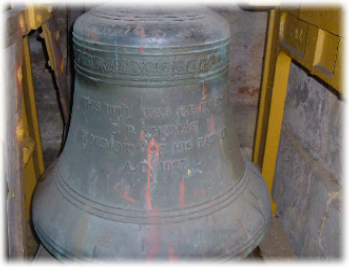
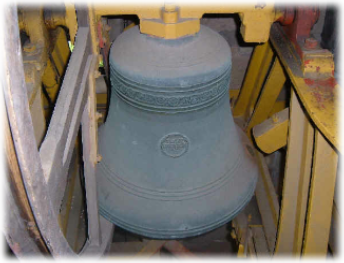
BELL 5 and BELL 4. Bell 5, left inscribed “This bell was given by EP Thomas in memory of his father, AD 1927. Bell 4, right is inscribed “EPT A.D 1927”.


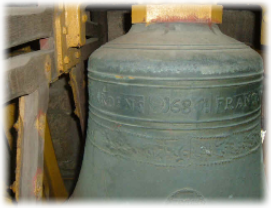
BELL 6. The mystery solved! The mark shows that this bell was re-
BELLS 9, 8 and 7. Left, Bell 9 ( 'Jesus be oure spede 1623'), centre Bell 8 ('Gloria in Excelsis Deo 1622) and right Bell 7, showing the Warner casting mark from 1886. This was most likely re-

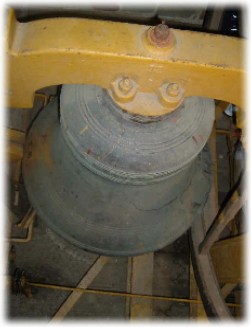

TENOR (BELL 10). This is the largest and one of the oldest bells. On the left you can see the cast iron headstock. On the right the bell wheel and inside of the bell. Bells were “tuned” by chipping the bronze from the inside or outside surface of the bell. These marks can clearly be seen on the rim. The bell is inscribed “God bless oure Nobell King” 1623.
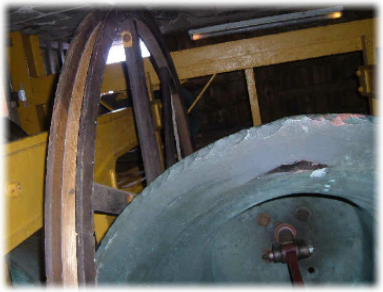
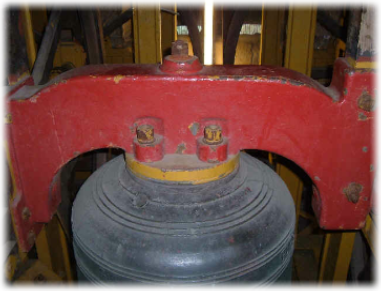
Only by some extremely adventurous climbing and squeezing is it possible to get to see many of the bells other than the tenor which looms ominously over your head as you enter. The only way to the top of the tower is through this chamber so it helps if you are pretty slim to go onwards! It would be an impossible place to be when the bells were in action.
The bells are laid out in the chamber in two layers, with bells 3,5,7,9 and 10 on the first layer and bells 1,2,4,6 and 8 above them.
Photographs of the bells follow.
This is a similar sized room without the benefit of many windows. It is literally a mass of bells, bell wheels, yellow ironwork of the bell frames and red-

Bells and bell wheels in the bell chamber

Clock chime wires from the clock mechanism to the bells above
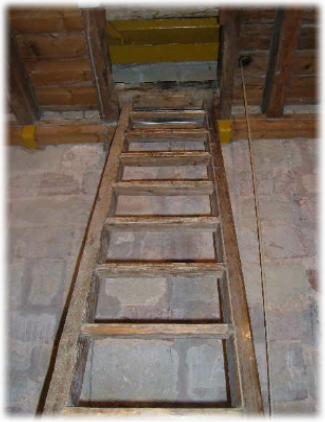
Steps leading from the clock room to the bell chamber
There is a confusing mass of wire ropes connecting the clock mechanism to the bells that are used to ring the clock chimes. The clock hammers strike on bells 4,5,6,9 and 10.
Another wooden ladder then leads you upwards into the bell chamber.
This room benefits from several leaded windows and has been visited regularly over the years by those keen to leave their mark. Inscriptions start from about 1613 and include some poignant carvings. A set of carvings from 1900 was left by George Stone, aged 11 (who was later killed in the First World War, having only spent one day with his new wife), F. Garland, James Drinkwater aged 13 and V. Kibblewhite (the son of the then Claines School Headmaster).
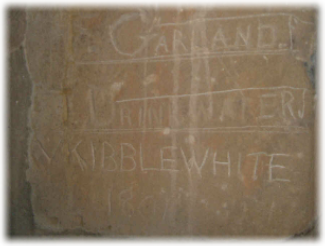
Carvings from 1900

Back boards “drawing” the bell ropes.

Bell ties
Also here are bell ties (wooden bars to stop the clapper ringing for practice sessions) and the bell rope back boards. These are wooden boards which guide (draw) the bell ropes for all of the bells except 9 and 10.
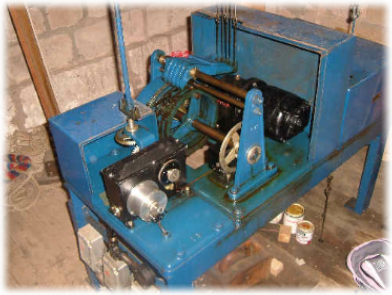
The electric clock and chiming mechanism
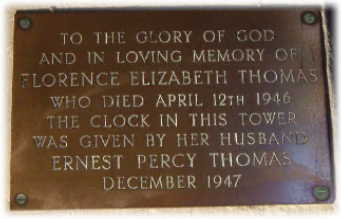
Plate in tower recalling the clock donation
The bells in Claines are rung from the base, or ground floor of the tower. There is no ringing loft. To access the tower a slightly unnerving climb has to be made up a wooden ladder and then through a wooden trapdoor. You climb 28 steps up a wooden rung ladder, squeezing past the ironwork of the bell rope guides. You then enter through a wooden trap door into the clock chamber. This is a room which contains the electric clock mechanism, various tools and spare parts for the bells and clock service records. The clock was made by John Smith & Sons, Midland Clockworks, Derby and installed in 1947.
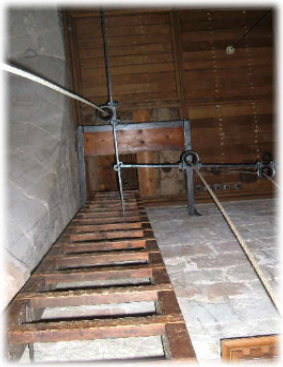
Climbing up into the tower
A discrepancy still exists as the monuments recall that only three bells were donated in 1927, yet Bagley records four from 1927. Only by visiting the bell chamber can this be resolved.
The rest of our bell history becomes somewhat easier to follow. In 1927 three new bells were donated by Mr Ernest Thomas. From the 1890’s until the 1940’s Thomas & Sons manufactured wind pumps in Claines. These were sold all around the world as “Climax” Windmills and won awards at the 1903 Royal Agricultural Society of England Show(6). The patent still exists and “Climax” windmills are now made in South Africa. Due to this, Emanuel Thomas was known locally as “Pumpy Thomas”. Both father and son were tremendous benefactors to Claines Church. There are numerous memorials in the tower noting the gift of the Church Clock, the re-
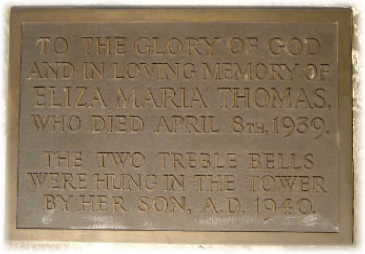
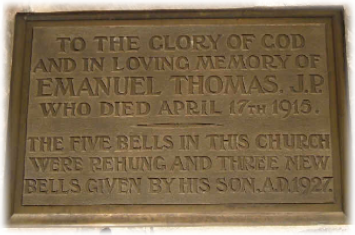
A few notes on the bell founders (5).
- Our three oldest bells are recorded as being cast by Richard Oldfield of Lindridge. Other than Claines the only remaining bells in the Worcester Diocese are at Lindridge (St Lawrence) and Mamble (St John Baptist). The Claines bell of 1622 appears to be the oldest surviving.
- John Warner, who cast our 1886 bell, has 34 bells in the Worcester diocese cast from 1856 to 1914.
- John Taylor and Co is a foundry still in operation at Loughborough. There are 338 bells cast by them in the Worcester diocese alone.

This leaves a slight mystery regarding the fate of the treble bell recorded in 1913. ('Francis Wythes, William Reynolds, Churchwardens 1686'). According to Bagley(4), this bell was cast in 1686 by William Huntbach of Worcester who was not a successful founder. In 1686 the parish registers for 19th August record the hanging of the Huntbach bell and it is mentioned in the accounts of April 1686 and 18th Sept 1688. The only bells by him still hung in the area are the unringable bells at Kington, Worcs (3 bells) and Mordiford, Herfs (5 bells). Two bells he supplied for Ludlow in 1690 were returned to him a couple of years later! Perhaps we can assume that this bell was re-

As the photograph above shows, at the time of the addition of the three new 1927 bells, all the bells were removed and rehung. The inscription reads “Claines Church Bells, Worcs. Augmented to 8 by 3 new trebles. 1927. Tenor 13 cwt, 3 qrs 26lbs. Taylors, Bellfounders, Loughborough”
Before continuing upwards, we can now present the complete information on the bells and their history in the table below.
|
Bell |
Founder |
Foundry Location |
Date of casting |
Weight |
Inscription |
Notes |
|
1 |
John Taylor |
Loughborough |
1940 |
3- |
In memory of Eliza Maria Thomas, who died April 8th 1939. This bell was given by her son |
|
|
2 |
John Taylor |
Loughborough |
1940 |
3- |
In memory of Eliza Maria Thomas, who died April 8th 1939. This bell was given by her son |
|
|
3 |
John Taylor |
Loughborough |
1927 |
3- |
EPT A.D 1927 |
|
|
4 |
John Taylor |
Loughborough |
1927 |
3- |
EPT A.D 1927 |
|
|
5 |
John Taylor |
Loughborough |
1927 |
4- |
This bell was given by EP Thomas in memory of his father, AD 1927 |
|
|
6 |
John Taylor |
Loughborough |
1927 |
5- |
'Francis Wythes, William Reynolds, Churchwardens 1686'. Recast 1927 |
Originally cast 1686 by William Huntbach of Worcester. Bell 1 until 1927 |
|
7 |
J Warner & Sons |
London |
1886 |
5- |
J Warner & Sons London 1886 |
Probably recast from the Alphabet Bell, which was cast in 1380 and recast 1383. Bell 2 until 1927. |
|
8 |
Richard Oldfield |
Lindridge |
1622 |
7- |
Gloria in Excelsis Deo 1622 |
Bell 3 until 1927 |
|
9 |
Richard Oldfield |
Lindridge |
1623 |
9- |
Jesus be oure spede 1623' |
Bell 4 until 1927 |
|
10 |
Richard Oldfield |
Lindridge |
1623 |
13- |
God bless oure Nobell King 1623 |
Bell 5 until 1927 |
Having solved the mystery of the bells and clambered though the steelwork it is refreshing to climb the third and final ladder into the fresh air on the very top of the tower (that is only if you are strong enough to lift the leaded trap door!).
Great views of the parish await you.

Church Farm
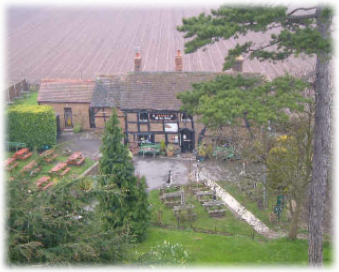
The Mug House
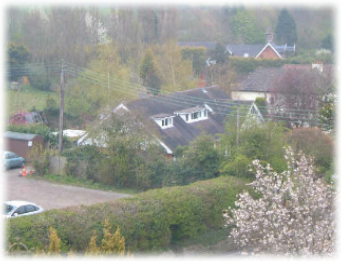
The current Vicarage

The Church Institute
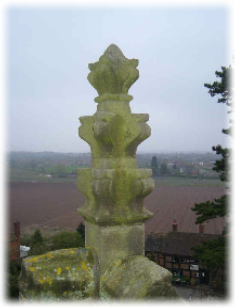
A Pinnacle of the tower

Another Pinnacle of the tower,
Gordon Smith, the Tower Keeper, and Claines bell ringer for 41 years
The descent via three ladders awaits you and on the way down you notice more things!
A box of leather muffles are to be seen in the clock chamber. These are used to cover one side of the bell clapper when ringing a “muffled peal”.
Muffled peals are occasionally rung, particularly to mark the death of a member of the Royal family or local clergy. The effect of the muffle is such that one ring of the bell is normal but the other ring of the bell muffled, giving the effect of a haunting echo.

Looking down
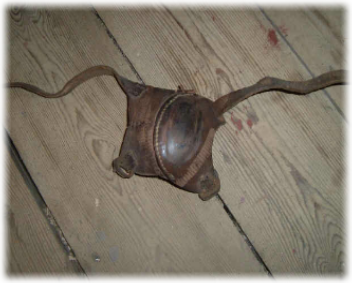
Muffle
Where the bell ropes go through the (first) ceiling into the clock room there are four metal framed holes. These show that at one time Claines would have had an “Ellacombe frame”. This was a frame onto which 4 or 5 numbered bell ropes would be tied, the other ends of which were operating a bell ring mechanism. These could then be “played” by one person pulling alternate ropes to make simple tunes. We do not know what the ringing mechanism was at Claines. It is possible the ropes rang the main bells. It is also possible that they rang smaller fixed bells or even tube bells.
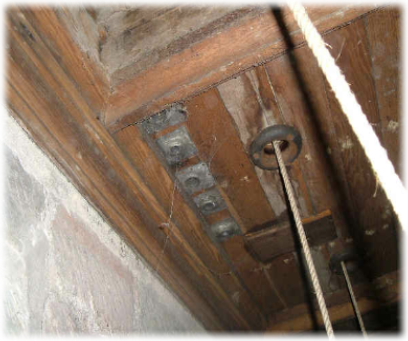
Current bell ropes entering the clock chamber, but also note the old metal guides for the Ellacombe frame ropes

When you are finally back on the solid ground the tower and belfry take on a new light. You can make sense of the ten bell ropes which, like the bells, are tightly packed. A diagram showing the ropes in relation to which bells they ring is shown opposite. It shows how tightly packed those ringers on the south side are.
Returning to the belfry, it is worthwhile mentioning the numerous “ringing boards” that record the feats of Claines bell ringers, past and present.
These are also known as “Peal Boards”. These are usually a carved or painted board recording the ringing of a peal, with details of the peal length, date, method, names of ringers, and perhaps a dedication. A full peal consist of between 5000 and 5280 bell changes and about 3 hours of bell ringing. A quarter peal would take about 45 minutes. (An explanation of the changes of ringing within this time is beyond the scope of this article, the author and beyond anyone but an experienced ringer. It is sufficient to say that if all the possible mathematical permutations of changes on a peal of 8 bells were rung it would take about 17 hours of ringing!)
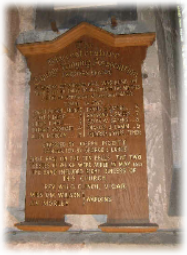
Peal boards in Claines tower recalling peals rung in 1963, 1943 (First peal on the ten bells), 1953 (Coronation of Queen Elizabeth II) and a muffled peal in 1936 for funeral of King George VI in 1936

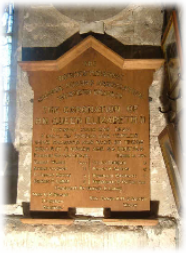
Peals were generally rung to celebrate a certain event or as a memorial to a person or event. Also peals are occasionally ring by groups of visiting ringers, who will add a “tower” to their list of towers rung. Peals are recorded in the “Felstead Peals Database” providing they have been registered. This records that 184 peals have been rung between 1927 and 2004 at Claines.
A prominent name on the peal boards is that of George Large, who “conducted” many of the peals. If you watch and listen to bell ringers you will find there is generally one who shouts out the commands, which invariably appear to anyone else other than a trained bell ringer as a set of very strange numbers or instructions. That person is the conductor. George was a previous Tower Captain at Claines. He was also employed by “Pumpy”Thomas and it was the bell ringing connection that led to his employment in Claines in 1933.
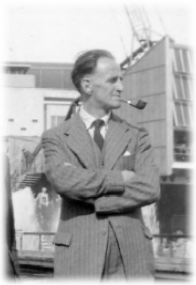
George Large 1951

George Large, with visiting ringers at Holy Trinity Stratford, front, far right, accompanied by his daughter, Wendy. 1950’s.
Other names include Reg Woodyatt, who was presented with a clock on August 7th 1977 to celebrate his 50 years as Bell ringer and Tower Keeper at Claines. He was succeeded by Robin Drinkwater and then Gordon Smith, our current Tower Keeper.
Claines has an active band of ringers who operate as part of the Worcestershire and Districts Change Ringing Association.
The Tower Captain (Master of the Ringers) is Martyn Hills, who has held that position for 24 years. Gordon Smith is the Tower Keeper.
The ringing band is made up of regulars from Claines and many visitors from near and far, who are always welcome. Many of our ringers are young people and new learners are always welcome. Bell ringing practice is on Wednesday evenings and the bells are regularly rung before Sunday morning service (10.15 – 10.55 a.m).
Groups of visiting ringers are welcome by arrangement and Claines is a popular destination for them, possibly owing to the fact that refreshment for thirsty ringers is very conveniently available from the Mug House next door.
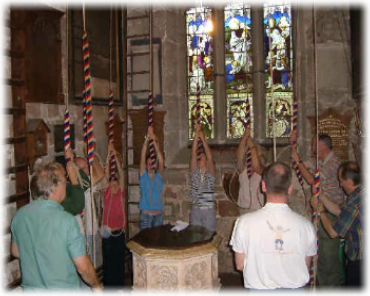
All ten bells being rung at Claines
Tower Captain Martyn Hills (left) with Claines ringers, on winning a striking competition, 2007
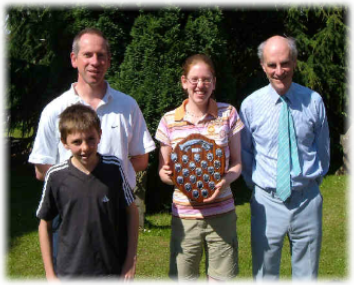
- Gordon Smith, Tower Keeper for his guided tour and his intricate knowledge of the tower.
- Martyn Hills, Tower Captain, for his advice on terminology and content.
- Wendy Galassini (nee Large) for the photographs and information for George Large, her father.
- George Sansome and John Sansome for taking notes and recording photographs during the “ascent”.
1. Littleburys Directory 1879.
2. History of the County of Worcester:J.W.Willis-
3. “Stray notes on a Church in Worcestershire”; Claines in 1846, from “The Rambler” John Noakes 1851. (See “The Mirror” article on this site)
4. A Ringers Guide to Towers in Worcestershire, David Bagley, incorporating Walters 1930, C.J.Pickford 1993.
5. A National Bell Register, (George Dawson)
6. Journal of the Royal Agricultural Society of England. Vol 64 1903
7. David Bagley, personal communication, based on Chris Pickford’s notes of Claines registers and accounts.
8. The Development of British Bell Fittings. Trevor S Jennings (1991).
9. Presentment records of the church court, as described in “Worcestershire’s Hidden Past”; Bill Gwilliam; 1991. Originals at Worcester Records Office
Date of writing: April 2008



The system was devised by Reverend Henry Thomas Ellacombe of Gloucestershire, who first installed such a system in 1821. It is believed he created the system to make bell-
|
Current Bell Number |
1913 Bell Number |
Founder |
Date of casting |
Notes and Bell Inscriptions |
|
6 |
1 |
John Taylor |
1927 |
? Recast? |
|
7 |
2 |
J Warner & Sons |
1886 |
Recast by Warner of London in 1886 from a bell said to have been of the late 14th century, possibly the original Alphabet bell, recast for the third time! Probably also the “vain coquette” referred to by John Noakes, 1846. |
|
8 |
3 |
Richard Oldfield |
1622 |
'Gloria in Excelsis Deo 1622' |
|
9 |
4 |
Richard Oldfield |
1623 |
'Jesus be oure spede 1623' |
|
10 |
5 |
Richard Oldfield |
1623 |
'God bless oure Nobell King 1623.' |
With reference to the 1913 record we can therefore assume the following;
|
Bell |
Founder |
Foundry Location |
Date of casting |
Weight |
|
1 |
John Taylor |
Loughborough |
1940 |
3- |
|
2 |
John Taylor |
Loughborough |
1940 |
3- |
|
3 |
John Taylor |
Loughborough |
1927 |
3- |
|
4 |
John Taylor |
Loughborough |
1927 |
3- |
|
5 |
John Taylor |
Loughborough |
1927 |
4- |
|
6 |
John Taylor |
Loughborough |
1927 |
5- |
|
7 |
J Warner & Sons |
London |
1886 |
5- |
|
8 |
Richard Oldfield |
Lindridge |
1622 |
7- |
|
9 |
Richard Oldfield |
Lindridge |
1623 |
9 |
|
10 |
Richard Oldfield |
Lindridge |
1623 |
13- |
The first mention of bells at Claines Church is found in the Church registers of 1380 which record that the first bell was hung at Claines, the Alphabet Bell. Apparently this had a strange inscription around it consisting of two alphabets. Unfortunately the registers of 1383 record that the Alphabet Bell broke and was recast!
In 1552 the registers record (7), there were "iiij (4) bells in the tower with ij (2) liche bells and iij (3) saunce bells". A saunce bell was a small bell rung during the mass, either portable or fixed in a small roof turret. A liche (Lych) bell was a small bell rung at funeral processions, being carried alongside the corpse.
The next mention we have is from the registers of 1589 (1) which say the great bell “was cast in ye Church House, A.D. 1589, Novr. 7th.” In those days apparently it was common practice to make a casting pit and foundry close by to the church, cast the bell there, so as not to have to transport it too far. (As to the location of the Church House, it is referred to many times in the registers. The registers of 1773 record that the old Church House was converted to Almshouses. We believe this refers to buildings that adjoined the Mug House, long since gone. Up to 1861 the Church House, presumably the new one, was the home of the Vicar, until the Vicarage up School Bank was built. The (newer) Church House is now the site of the farmhouse for Church Farm).
Another common practice was to “re-
The parish registers record various occasions of public rejoicing for which the bells were rung and fees paid to the bell ringers;
- 1683 “Claines bells ring out to celebrate the victory of the Christians over the Turks in Vienna”. 2/6d
- 1805 Battle of Trafalgar 5/10d
- 1814 Napoleon’s banishment to Elba 4/8d
In 1697 an incident with Claines Bells was recorded in the presentments of the Church Court. For misbehaviour in the Church at Claines in 1697 John Randall and James Ford, Junior, were presented for breaking into the church and for “ringing and jangling the bells....The said Randall laying hands upon the Clerk’s wife, taking her fast by the throat and threatening that he would kill her if she should tell that she saw them in church”.(9)
There was obviously a problem with one of the bells. In 1832 the parish approached John Rudhall, from a well established Gloucestershire bell founding family, for recasting the second bell (of 5). He also gave them a quote for a treble bell to make six (7). Nothing was done at that time, and it was that bell which was eventually recast by Warners in 1886, as we find from some later information below.
In 1913 (2) the bells were recorded as follows:
“There is a ring of five bells inscribed as follows: treble, 'Francis Wythes, William Reynolds, Churchwardens 1686'; second, recast by Warner of London in 1886 from a bell said to have been of the late 14th century; third, 'Gloria in Excelsis Deo 1622'; fourth, 'Jesus be oure spede 1623'; tenor, 'God bless oure Nobell King 1623.'
In 1846 John Noakes (3), on a visit to Claines, wrote about the popularity of Claines as a wedding venue; “No wonder then that with this amount of business on the hands of the ringers, and the constant excuses the fraternity will make for the exercise of their vocation, the ears of the villagers are dinned perpetually; and no wonder that one of the bells, wearied with so much babbling on marriages, like a vain coquette, is at last grown old, cracked, and unfit for service.” Some may say, that apart from the cracked bell, not a lot has changed!
Before trying to unravel the full history of our bells it is best presenting what is currently recorded. Our starting point is provided by “A Ringer’s Guide to Towers In Worcestershire” by D Bagley (4).
Claines Church is unusual in that it has ten bells. They are heard regularly, but not too many people are able to climb the wooden ladder and squeeze past the bell frames to see them. Only by doing so are you also able to take advantage of the wonderful views from the top of the Church tower. This article will help you experience that journey, provide the known history of our bells and inform you about many other things to do with the tower and bell ringers.
Before we embark, a few words of explanation around bell-
- The smallest and highest sounding bell is known as the treble.
- The lowest, biggest and heaviest bell is known as the tenor.
- A ring of bells refers to how many bells there are, for example a ring of five.
- The back bells (i.e the back four or the back five) are those bells in ascending order from the tenor bell.
- The weight of bells is usually referred to in hundredweight (112 lbs or approximately 50 kilograms). This gets more complicated as they will generally be described in hundredweight:quarters:lbs.
- As bells are tuned to one another, then usually only the pitch of the tenor is described, e.g F#.
- Other bells above the tenor are tuned in whole tones, that is they play “up a scale”.
So if we take Claines as an example we have:
“ A ring of ten, Tenor 13-
This means there are ten bells, the lowest of which weighs 1556 lbs (13 hundredweight (1456lbs), 3 quarters (84 lbs) and 26 lbs, or in total 1556 lbs) and sounds the note F# when rung.
Usually the bells above the tenor will be pitched to form a complete or incomplete scale above it. This is the case in Claines where the tenor plus the next seven bells make the compete scale of F#, or an octave. If rung in ascending order from the tenor they will play the scale of F# major plus another two notes. Some would describe this as “an octave plus two”.
This does actually mean that it is quite possible to play tunes on the bells! However this is difficult, if not impossible when they are rung by hand. Some churches have carillon mechanisms that do this. It is possible to ring all or some of the bells, for example five or six. However to the musician’s ear it is sometimes painful to hear, as when the “wrong” bells are chosen an incomplete scale can be sounded which the musician wishes to hear resolved!
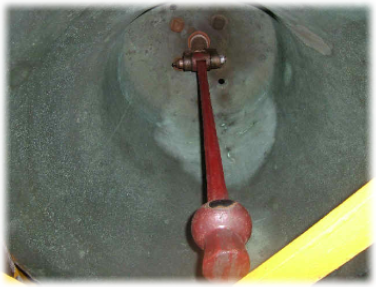
Looking up into the 1623 tenor bell
Finaly just to make it completely confusing if say only 5 of 8 bells are rung, whilst ringing, the highest bell becomes known as the treble and the lower the tenor, whether they are the real treble or tenor or not!